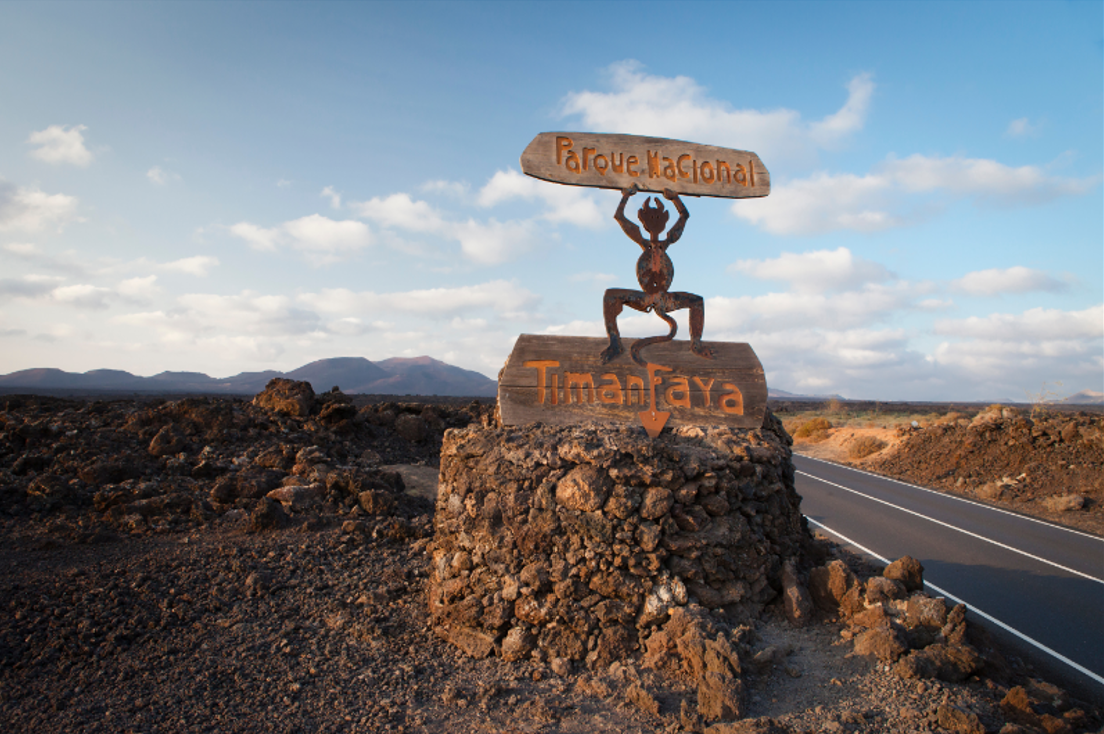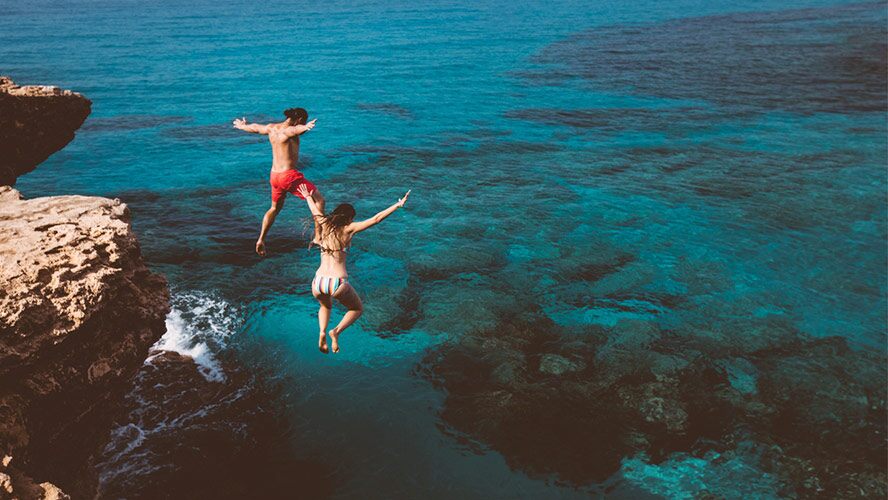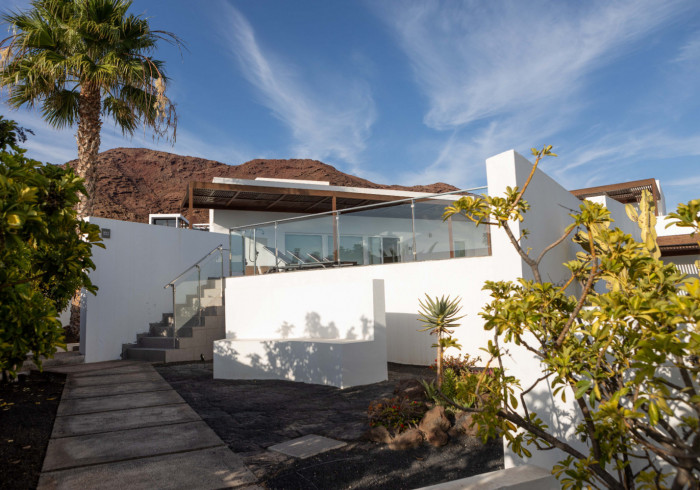Volcanoes, beaches, monuments, lovely villages, unique landscapes … This and much more can be discovered on Lanzarote.
But … you have never been on Lanzarote before and you are not sure what you should visit on the island of Lanzarote? Just read the below – we show to you all these sites that you should definitely visit during your stay at Hoopoe Villas Lanzarote.
Timanfaya National Park
The National Park of Timanfaya and the Montañas de Fuego (Fire Mountains) is for sure a unique lunar landscape! Due to the volcanic eruptions from 1730 to 1736, the Timanfaya National Park and the
Montañas del Fuego (Fire Mountains) emerged as a unique natural wonder and a thrilling sight for visitors.
The extreme heat, which is only a few meters below the surface, is demonstrated right next to the parking area. In the El Diablo restaurant, the meat is prepared on a natural grill powered by geothermal energy. Furthermore, visitors can drive through the Fire Mountains in special vehicles and enjoy a unique experience in the midst of this unique lunar landscape.
And if you finally wish to feel like a real explorer of wild, unknown lands, a ride on a camel through the foothills of the national park is the perfect complement. This ride is suitable for visitors of all ages.
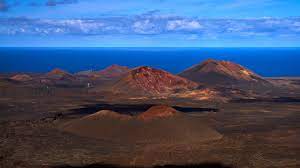
El Golfo
The volcanic landscapes of Lanzarote can be very different. This is particularly evident in El Golfo. El Golfo is a small fishing village, many restaurants offer fresh fish every day and a spectacular sunset. At the edge of this village, in the middle of the dark colored volcanic landscape, there is a small lagoon, the water of which is given its intense green color by algae.
Los Hervideros
In the Southwest of Lanzarote you can find the bizarre rocky coast of Los Hervideros situated between the fishing village of El Golfo and the Salinas de Janubio. The rock masses were formed during the last major volcanic eruptions between 1730 and 1736, when the hot lava masses poured into the sea and solidified.
Sometimes, when the Atlantic Ocean is rough and producing heavy swells, sprays of seawater are forced several meters into the air accompanied by a roaring noise!
The lava rocks have collapsed and hollowed out partly because of the strong waves on this part of the coast. Visitors can wander around pathways in the cliffs and watch the display below.
Salinas del Janubio
On the south coast of Lanzarote, near the fishing village of El Golfo, we find the salt production plant Salinas de Janubio, which is separated from the open sea by a headland. The terraced salt marshes are one of the most beautiful sights on the island, as they shimmer in fascinating colors when the sun shines.
In 1895 the construction of the Salinas de Janubio began. In earlier times, windmills pumped the salty seawater into the terraced basins. Electric pumps later took on this task. As a result of the sun’s rays, the water evaporated, became heavily enriched with salt, and was channeled into smaller basins. The salt could crystallize in the small basin and was later skimmed off. In former times, the sea salt was used as a preservative by the fishermen. In the early 19th century, 10,000 tons of sea salt were being produced annually.

Jameos del Agua
We continue to the north of Lanzarote, where one of the most popular excursion destinations is situated, the Jameos del Agua. The Jameos del Agua is part of the seven-kilometer-long cave, produced by the eruption of the volcano La Corona. Jameos del Agua is located in the nearest part of the coast of this tunnel.The lava tunnel was created around 4500 years ago when hot lava masses flowed into the ocean during a powerful volcanic eruption. The upper layers cooled down quickly, while below, glowing-hot lava flowed through the tunnel towards the sea.
In the 1960s, the island government decided to develop the cave as an art and cultural center. The construction work was planned and directed by the artist and conservationist César Manrique. In 1966 the facilities were opened for tourism. The centerpiece of the cave is a concert hall with around 600 seats and great acoustics. There is also an underground lake in a grotto, which is filled with sea water. Albino crabs, which are normally only found in a water depth of 2000 meters, live in them.

Cueva de los Verdes
Another interesting destination in the north of the island is the lava cave called Cueva de los Verdes. Cueva de los Verdes belongs to the same tunnel system as the Jameos del Agua, situated below the La Corona volcano. The approximately seven kilometer long tunnel system is the longest volcanic passage system in the world.
The tunnel system was created about 3000-4500 years ago during a massive volcanic eruption of Montana Corona. Huge streams of lava flowed across the land towards the sea. The superficial lava flows cooled down quickly and solidified in the air. On the same time, the lower lava river continued to flow beneath the solidified surface, leaving a cave when the lava flow finally dried up.
This cave has been used for tourist purposes since 1964. Cueva de los Verdes may only be entered under supervision, daily tours take place between 10 a.m. and 6 p.m. The accessible, one kilometer long part of the cave consists of two long tubes lying on top of each other. On the 50 meter deep descent, bizarre lava formations can be admired.
During the forty-minute tour one arrives at an astonishingly large, natural cave, which offers space for approx. 300 visitors. This hall, equipped with a stage, serves as a concert hall because of its unique acoustics.
At the end of the tour, the visitors arrive at a beautiful, small freshwater lake, where dreamlike effects are achieved with special light. The cave’s sophisticated lighting was installed by the artist Jesus Soto.
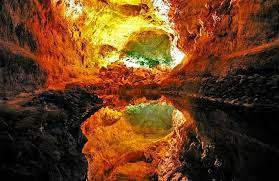
Mirador del Rio
From this unique view point, you can admire the entire northwest coast of the island and on sunny days also the island of La Graciosa.
In 1973 the well-known artist César Manrique designed the Mirador del Rio together with Jesús Rafael Soto, which was officially opened a year later.
When it was completed, the plant was one of the most modern structures in the world. At this point there was an important military base during the Cuban War towards the end of the 19th century, the remains of which can still be discovered in the surroundings of this view point.
Jardín de Cactus
Between the villages Guatiza and Mala is the last great work of the lanzerotic artist César Manrique situated. The huge cactus garden was built into a former quarry. Construction began in 1989 with the help of Manrique, and the garden was officially opened just two years later.
At the entrance to the cactus garden there is installed an oversized, eight-meter-high cactus sculpture made of metal. The restored mill on the northern edge of the garden offers a fantastic view over the cactus garden and its surroundings.
More than 10,000 specimens of over 1,400 different species of cactus are growing on a total area of 5,000 square meters. Built like an amphitheater, the botanical garden was laid out in terraces, the ground is covered with a volcanic granulate (picón), which spokes the dew. This dry field cultivation, which is also common in agriculture on Lanzarote, gives plants the opportunity to grow up on the rain-poor island.


